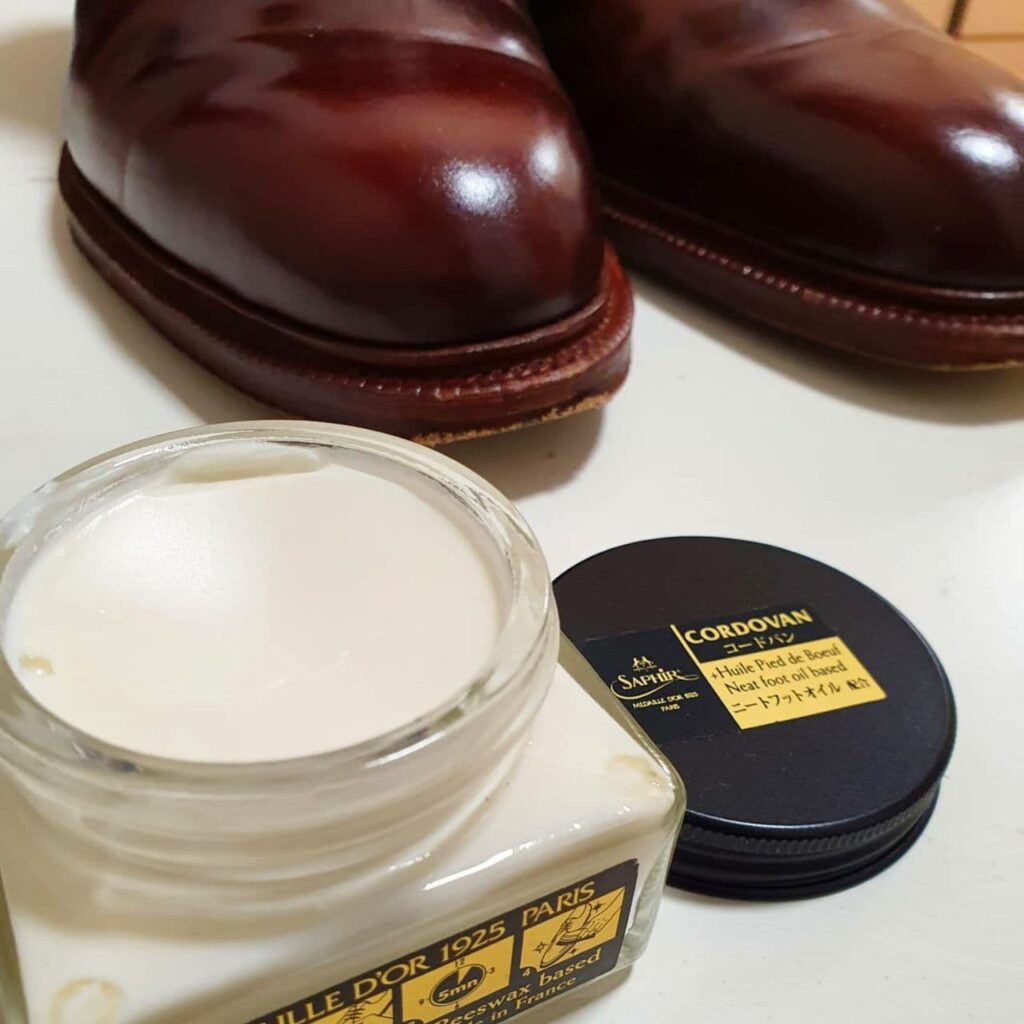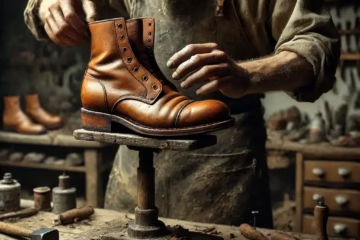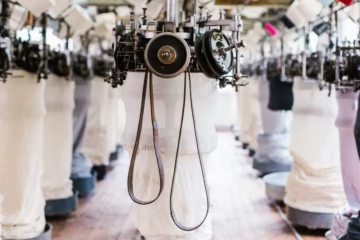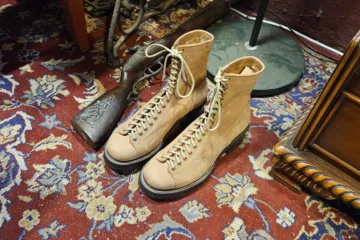3 Basics about shoe wax and shoe polish.
Published by Tom on
When talking about shoe polishes, a wax polish that brings a mirror-like shine to your shoes is typically what comes into everyone’s mind. In order to take care of your shoes properly, you’ll need more than a wax polish to keep your shoes in great shape. You may have come across another type of polish – the cream polish.
Several questions usually come into mind when talking about the shoe polish. What is the difference between wax and cream polish? Which should you use? Can one be replaced for the other?
This article will try to explain the difference between the two and talk about shoe polish in detail.

What is a shoe wax?
A shoe wax is a type of shoe polish with lower pigment concentrations but has a high concentration of hard waxes. It allows them to form a smoother layer over the pitted surface of a leather grain. This creates a glossy look, which is essentially the desired mirror-like finish on the shoe surface.
As more hard wax is added, it makes the shoe smoother surface and the reflections clearer, creating a shiny look. Colored wax shoe polishes can be used to fill in and hide minor scratch marks in your shoes, commonly on toe caps.
Like cream polishes, the wax polish wax layer is only present in the top layer. They can be both easily removed with a leather cleaner. It is also important to note that waxes are hydrophobic (anti-water). Therefore wax polishes confer a considerable amount of water resistance to your shoes, which is essential for its durability.
Wax polishes are typically applied using a dauber brush, hands or with a shammy cloth which is then allowed to dry, then buffed to a glossy shine using a horsehair buffing brush. Just like using cream polish, an exact match in color is not necessarily required. Some shoe owners add black wax to the edges of their lighter colored shoes to give way to a patina-like effect. It is because of the low pigment concentration of wax polishes that makes them easy to control.
How are they made?
Shoe polish is made of a blend of waxes, solvents, oils, and dyes, in different percentages, based on their type. A mix of waxes with different melting points is utilized to arrive at a trade-off between simplicity and shine. The biggest difference between the expensive shoe polish and the cheaper shoe polish is that the cheaper one uses paraffin as their base. But the more expensive waxes like Saphir use more natural ingredients such as beeswax. You can tell the difference from the smell of the wax.
(Of course expensive brands won’t share their shoe polish mix ratio to others because often it’s their secret recipe, but they do work.)
When the polish is applied to your shoes, the friction creates enough warmth to soften the paste layer into a thick fluid that moves to the leather, coursing through scuffs and cracks. The oils hinder the leather’s oxidation process and keep it flexible, while the colors help with the shading.
At first, the polish looks matte and dull because the rough wax diffracts light at a minute level. However, after you polish the shoes, the wax is dissolved and the leather gets that sparkling, shiny look.
Waxes
Shoe polish contains either natural or synthetic waxes or a blend of both. The primary kinds of waxes utilized are:
- Paraffin – an oil-based wax
- Carnauba – a plant-based wax
- Beeswax – a bug-based wax
Solvents
Solvents are utilized to coordinate the wax and make it simpler to apply.
- Naphtha – Petroleum distillate
- Turpentine – Pine Tree pitch distillate
- Stoddard Solution – Mineral Spirits
Oils
Oils are liable for protecting the leather, which is why you’ll see them utilized in most shoe conditioners. The primary kinds of oils used are:
- Lanolin
- Mink Oil
- Neatsfoot Oil
- Collagen
Plant-based oils like olive oil or nut oil are not utilized in shoe shines.
Colors
Contingent upon shoe polish shade, different colors are utilized, the most widely recognized being carbon black and azo dye.
Shoe polish composition.
Depending on each kind of shoe polish’s composition, there are three main types of shoe polishes:
Wax-based shoe polish
Wax-based shoe polish is a hard polish that comes in solid form. It’s composed of waxes (about 20-40%), solvents (around 70%), and dyes (2—3%).
Because of the high percentage of volatile solvents, wax-based shoe polish hardens after applying it to your shoe while it maintains its glossiness. It’s harder to produce a shiny finish. Still, once you get that shine, it will last longer than other shoe polish preparations.
Cream – emulsion shoe polish
Cream polish is a shoe polish that contains more oils and less wax; hence it is softer. Due to its composition, the liquid content being at a higher percentage gives this kind of shoe polish a gelatinous consistency.
Due to a high oil concentration, this kind of shoe polish can act as a shoe conditioner. When polishing their shoes, some people use both a wax-based shoe polish and a cream-emulsion shoe polish when polishing their shoes to give it a more well-defined shine.
Cream polish is perfect for softer leather with many textures because it can get into the hard to reach nooks and crannies of your shoe much easier. The downside to this is that you can’t get a spit shine with this kind of shoe polish.
Liquid Shoe Polish
Liquid shoe polish has a minimal wax content and doesn’t condition your shoe. Instead, it adds a layer on the top of your shoe to protect it. Long-term, however, can cause your shoe’s leather to become dry and crack; therefore, if you’re not in a hurry, it’s not recommended.
Liquid shoe polish is faster and quick and easy to use. The protective layer can easily cover scuffs. Therefore, if the convenience of concern, it is the go-to option.
How often should I polish my shoes?
On average, your shoes need to be polished at least once a week. However, depending on how often you use your shoes, whether you use shoe trees or not, and how often you brush them, you get away with polishing them a couple of times a month.
Why should I polish my shoes?
Every responsible shoe owner knows the value of polishing their shoes. Polishing your shoes is not only necessary for aesthetic purposes, but it also increases the lifespan of your shoes. Polishing your shoes regularly protects your shoes by increasing their durability, water, and dirt resistance. It protects them from the usual scuffs and scratches. Otherwise, the leather will give up much quicker, and you’ll need to replace them or buy a new pair of shoes altogether.


